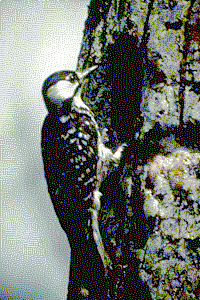
 |
RED-COCKADED WOODPECKER |

The U.S. Fish and Wildlife Service has prepared a recovery plan for the red-cockaded woodpecker (USFWS 1985) that proposes criteria for delisting the species. Among those criteria is the establishment of at least 15 viable populations across the species' range. Although it is not clear that this set of 15+ populations would meet all the criteria of a metapopulation (Levins 1969, 1970; Hanski et al. 1995), the principles of metapopulation dynamics may provide useful insights into how the recovery plan can be made to assure the continued viability of the red-cockaded woodpecker as a species.
The preferred pine-wiregrass savannah habitat of the red-cockaded woodpecker was once widely distributed across the southeastern United States. However, fire management, deforestation, forestry practice, and other changes in land use have reduced and fragmented this once common and relatively contiguous ecosystem type. Consequently, remaining populations of the once abundant and widespread red-cockaded woodpecker are fragmented, small, and isolated. These are characteristics of a regional metapopulation, and regional metapopulation dynamics might allow for the persistence of the species despite the highly fragmented distribution of pine-wiregrass habitat. However, because of the relatively recent history of habitat fragmentation and insularization, assumption of a regional metapopulation is unwarranted. Therefore, we do not assume a metapopulation structure for the red-cockaded woodpecker. Rather we ask a series of questions: (1) Can the red-cockaded woodpecker be managed as a regional metapopulation? (2) Is the current distribution of red-cockaded woodpecker habitat consistent with long-term regional persistence? and (3) If not, what changes in habitat distribution or other management interventions would promote regional persistence? Similarly, we do not assume a metapopulation model, but instead adopt a patch-based modeling approach from which metapopulation dynamics may or may not emerge. Our patch-based model takes the following form:
dNi/dt = ri Ni (1 - Ni/Ki) - Ei + Ci
where
Ei is due to environmental stochasticity (e.g., hurricane damage) and Ci = sum (cij), where cij, the colonization of population i from population j is a function of the distance from population j and the number of active clans in population j.
We are in the process of parameterizing the model with information currently available for red-cockaded woodpecker in the southeastern United States.
For further information contact Tony King or Tom Ashwood.
Hanski, I., T. Pakkala, M. Kuussaari, and G. Lei. 1995. Metapopulation persistence of an endangered butterfly in a fragmented landscape. OIKOS 72:21–28.
Landers, J. L., D. H. Van Lear, and W. D. Boyer. 1995. The longleaf pine forests of the Southeast: requiem or renaissance. J. For. 93:39–44.
Levins, R. 1969. Some demographic and genetic consequences of environmental heterogeneity for biological control. Bull. Entomol. Soc. Amer. 15:237–240.
Levins, R. 1970. Extinction. pp. 77-107 In M. Gesternhaber (ed.) Some Mathematical Problems in Biology. Amercian Mathematical Society, Providence, Rhode Island.
USFWS (U.S. Fish and Wildlife Service) 1985. Red-cockaded woodpecker recovery plan. U.S. Fish and Wildlife Service, Atlanta, Georgia. 88 pp.